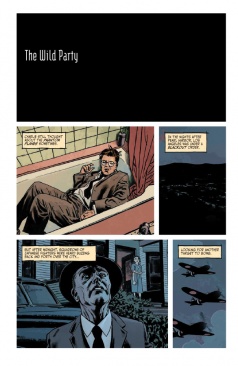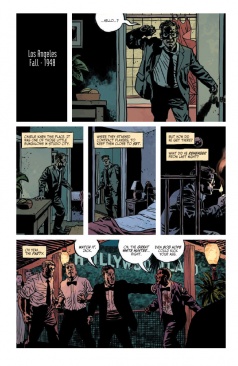
Out of all of the big names in modern monthly comics, the one writer we hadn’t spoken to before that we wanted to most was Ed Brubaker. Personally speaking,that was a shame, as he’s a guy who has been writing some of my favorite comics for over a decade, with his collaborations with artist Sean Phillips standing out in particular. “Sleeper”, “Criminal”, “Incognito” and “Fatale” have all blown me away in different ways, and their work together has become maybe the greatest creative partnership in comics’ modern era.
On Wednesday, their latest collaboration “The Fade Out” begins, and trust me when I say it might just be their strongest first issue yet. With the book launching so soon, we spoke with Brubaker about his partnership with Phillips, their five year deal with Image, his familial connection to the story, and a lot more. Take a look below, and make sure you check out this book. You won’t be sorry.

Ed Brubaker: Well, Sean is much faster than I am, strangely, and he just wanted to go right from one to the other. It ended up being a ton of work, of course, because the final issue of Fatale was double-sized, and the first issue of The Fade Out is about ten pages longer than most comics, too, so we had a ton of work to get done in two months. And I was juggling some screenwriting work around that at the same time. But even though it was a lot of late nights, we were really excited about getting into The Fade Out because it’s the first project on our five year “anything we want to do” deal at Image.
As for why this was our follow-up, I was actually debating whether to do this or a sci-fi idea I’d been noodling on for a few years, but I just felt, after Fatale, I wanted to do something much more real and grounded, and unlike anything else on the shelves right now. And I thought an epic noir murder mystery about sex and violence and scandal in old time Hollywood felt like a real challenge.
You mentioned the five year deal that you and Sean signed with Image, and I thought that was such a fascinating and exciting deal for comics. It would embolden anyone, I have to imagine, but what does that mean for you personally and creatively as a writer? Not that you’ve ever really been shackled from making the choices you want to make, but I have to imagine that deal was invigorating for you.

And honestly, I think our best work has been stuff where I just wrote what I wanted to write at that exact moment, and followed my own passions, and didn’t worry about whether there’d be an audience for it or not. So the Image deal allows me to just adopt that outlook on everything. I don’t have to sell anyone on my idea, I just have to write it. It’s the best deal anyone in comics has ever had. But if I didn’t have Sean constantly demanding script pages, that kind of freedom might actually be crippling. I’d be waffling back and forth forever on what to do, since I can do anything.
Continued belowBut a big part of why I chose for us to do The Fade Out as our first project on the 5 year deal is that it’s a big weird story unlike anything else on the stands right now. There’s no reason I’d think anyone is demanding a crime comic set in 40s Hollywood, but we’re just doing it anyway. Thankfully, the response so far has been amazing, and the final orders are the highest we’ve ever had, by a wide margin.
Series lead Charlie Parish is a screenwriter and Dotty Quinn is in publicity for the same studio he works for, which are roles your uncle John Paxton and aunt Sarah Jane once had respectively. You’ve previously written about how they were – or at least their work and stories – a huge part of why you ended up being so interested in noir. Does that personal connection make this project feel like something that was a lifetime in the making for you, and for the same reason, does it make it something you feel extra motivated to nail down the details on? I know you say in the back matter a research assistant, Amy Condit, was hired to make sure your Los Angeles of the 1940’s feels as real as it possibly can.

But hiring a research assistant was more for getting the period detail right in the art. Amy is an expert on this era (among other topics) and she compiled this huge file for reference that’s all categorized and organized just how Sean needs it, so he doesn’t spend days online every page looking for stuff. I figured, since it’s comics, why not make it look as close as possible to the real thing.
I’ve spend the past year reading books about old Hollywood for my own research, though, and getting a sense of the time and place and finding things that actually happened that fit into this story I’m writing. Which I guess is the real challenge of historical fiction. You want to tell your story and get the history as right as you can, but I’m sure I’ll mess that up here and there, because the story is more important, ultimately.
Sean’s obviously someone you love working with as a creative partner, and Elizabeth Breitweiser came on midway through “Fatale”, but between that project and “Velvet” it’s clear she’s someone you jive with. Their work marries together so well, and fits the world of “The Fade Out” to a T. For you as a writer, what does it mean to have collaborators like Sean and Elizabeth who you can trust completely to find the best way to bring out the story?
EB: It’s exactly what you said, I trust them completely. That’s so hard to find in this industry, to be able to create a cohesive team, without fill-ins or issues being colored or inked by ten different people because of crazy deadlines. Bettie’s colors are among the best in the field, and I feel lucky as hell to have her coloring both my comics. And I won’t give anyone else her email.
In looking at The Fade Out, one of the things that stands out is the way the period and voice is captured. You and Sean have long played with noir standards and archetypes, but where Criminal played with updated tropes, this seems more akin to Sweet Smell Of Success. While you’ve certainly shown yourself to be a fan of this kind of story and have spent quite some time refining the voice you use in your work, how have you found the challenge of dialing it back to a specific time period in order to match the specific tone of an era that has been so well defined?

Fatale had a rich mythology that pulled from things like Lovecraft, but The Fade Out has the mythology that was born out of the classic era of Hollywoodland — there’s Black Dahlia, George Reeves and of course Peg Entwistle. Given the research discussed, how have you found exploring this era and playing with it and putting the ol Brubaker/Phillips spin to it all?
EB: Well, doing anything that’s even remotely considered historical fiction is a lot of work. There’s a whole other layer of detail you have to keep in your head as you write. But I love this era, so it’s great to try to find places for my fiction and the real things that happened back then to collide.
You and Sean have explored noir in many different facets — from the modern epic, the superhero drama and the Lovecraftian horror. “The Fade Out” seems like the most classical iteration of your collected study of the storytelling style. Having been together for nearly 15 years, what do you find you and Sean are doing to push each other and the general tropes of the genre within this series?
EB: I never think about things like this, honestly. I rarely even think of any aspect of a genre as a trope. They’re all tools we can use to tell a story, and for me, that’s what it’s all about. I’m a storyteller, and anything I do to push myself is less about the genre I’m working in and more about the formal aspects of how I’m telling the story.
Me and Sean try to push ourselves because we don’t want to just do the same stories over and over again, so I’ll find some new path into a story, and Sean will look at his art and decide what he wants to try differently next time. For The Fade Out, Sean’s got a reality to recreate, and that’s a lot to accomplish, and I’m trying to weave an incredibly varied and complex narrative, which is its own kind of high wire act.

EB: Each issue is basically a juggling act. So far I’ve had to cut scenes from issues 1 and 2 and hold them for later issues. Having this many characters — there aren’t 40 main characters, but there are four or five different arcs weaving together around a pretty large cast — it makes it hard to fit everything into the issues. We always go at least 24 pages an issue, but there’s just not always room for everything I wanted.
As for my writing style, I know where my ending is, generally, but not how I’m going to get there. I know a lot of the big moments, but not exactly what issue they’ll happen in, things like that. I outline loosely and let images and scenes build in my subconscious, until they find the right place.
In recent years, quality back matter has become increasingly popular with books like Sex Criminals and Saga developing cult followings specifically to their letters columns. You were early on that with your creator-owned work, as at least since Criminal started, you’ve added value to the reading experience with guest essays from people like Jess Nevins and The Fade Out #1’s Devin Faraci. How did that idea first come together, and is it your plan to keep those going in the fertile ground of The Fade Out?
EB: For me, it came about because I need people to buy the single issues every month so we can keep doing the comics. So I decided to look at the issues as magazines we were serializing our stories in, and use those extra pages to talk about stuff and write articles and get Sean to do illustrations. I just want to make sure the comic is worth our readers’ money, and I want to reward them, because on books like Criminal and Fatale and now THE FADE OUT, our single issue readers are like our sponsors, basically. They buy enough copies of our comics that we can keep publishing more stories.
Trade and hardback and even digital sales are a long game, but most comics survive based on their single issue sales. So while I’m thankful to see our numbers get better every project, I never take those single issue readers for granted. They made it possible for me to stop writing superheroes and do things like THE FADE OUT instead.



